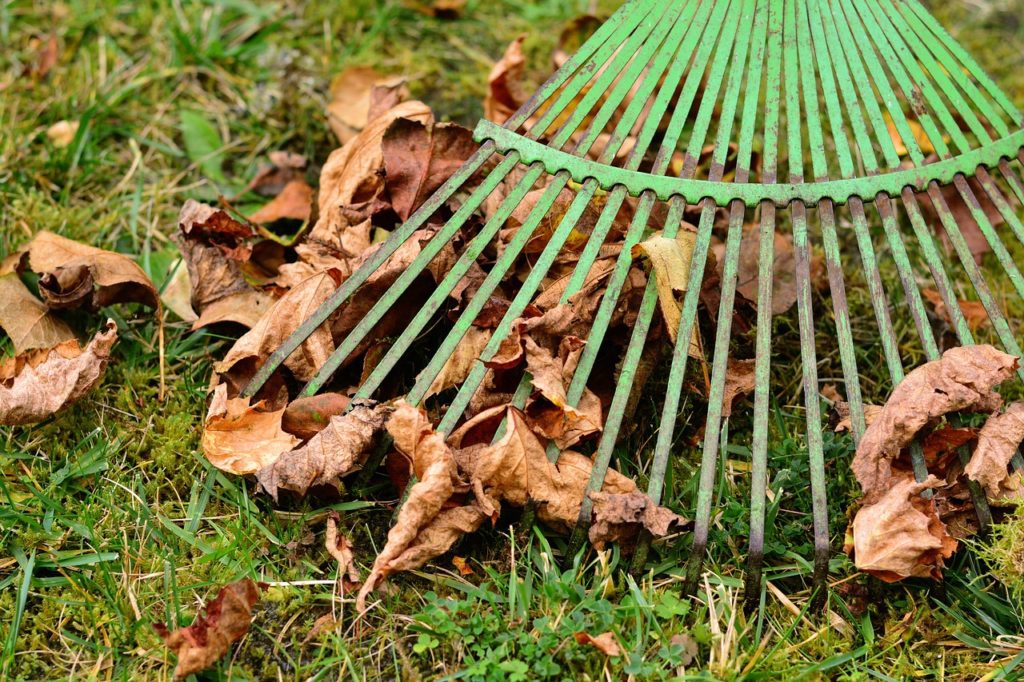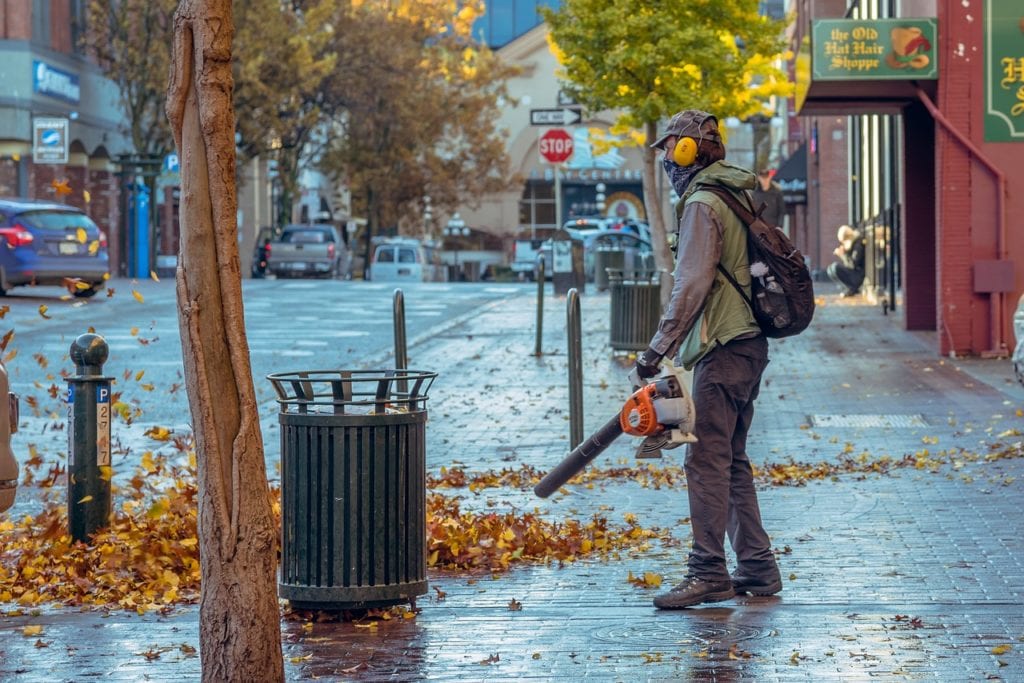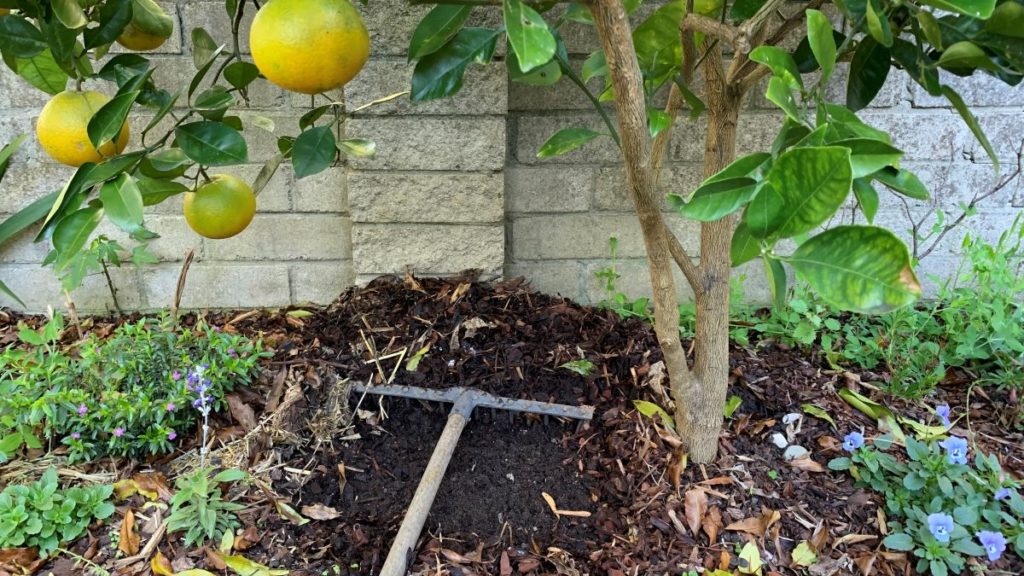Wet leaves are more difficult to mulch with a mower as they will stick in the blades and if left there, can cause rust or clog your mower. Leave wet leaves to dry out in your garden bed or rake them up and place them on your lawn to dry out. Run over the dry leaves with a mower to shred them and turn them into mulch.
Problems with mulching wet leaves – 3 Tips
1. Clogs up mower blades
Shredding wet leaves with a lawn mower or leaf blower can be difficult as they will stick to the blades and can clog up the shredder in low powered leaf blowers. Use a high powered, good quality leaf blower or mower and they will be able to shred damp leaves.
2. Difficult to pick up
Wet leaves will stick together, forming clumps and are more difficult to move. As you move wet leaves into piles they will compact, stick together and can form a soggy clump which can grow mold quickly.
When leaves are left in the sun for a short period of time, they will dry out quickly. Move leaves that are in shaded areas in your garden into a sunny area to help them to dry out.
Dry leaves are easier to shred and once shredded can be placed on top of garden beds as mulch or placed in a compost bin to break down and turn into a rich humus over a period of around 6 months.

3. Wet leaves can cause rust
Wet leaves can stick to the blades of your mower, if left there, they can cause rust. Mowing over wet leaves can make them easier to pick up, but excess leaves can get caught in your mower.
How to move wet leaves – 2 Tips
1. Raking wet leaves
Raking wet leaves is the best way to move them without clogging up your mower. A strong, metal rake will work best to move leaves off of lawns or garden beds. Wet leaves can be moved into your compost bin without mulching but they will break down quicker if shredded first.
3. Dealing with damp, wet or soaked leaves
Depending on how wet your leaves are will affect what you can do with them. If leaves are slightly damp, you will still be able to mow or vacuum them without problems.
If leaves are very wet, or have been recently soaked by rain, it is much better to let them dry out before mulching them.

How to compost wet leaves
To turn wet leaves into compost by mixing them together with other compost ingredients like straw, food scraps and coffee grounds.
Leaves can also be turned into compost or ‘leaf mold’ a rich, dark humus over 6 months by simply gathering a large amount of leaves and filling a wire cage. You will need around 4x4x4 feet of leaves for them to break down over 6 months and form a humus which can be dug back into your garden.
For more detail on how to do this, check out my previous article below.
Blowing vs vacuuming wet leaves
Blowing wet leaves can be difficult unless you have a powerful leaf blower.
Good quality leaf blowers can also vacuum damp leaves but the collection bag can quickly become heavy with the wet leaves. Empty the bag regularly when collecting wet leaves.

Bagging wet leaves
Wet leaves can be bagged while you clean up your yard and decide what you will be doing with them. Wet leaves that are placed in plastic bags will not dry and can quickly form mold and fungus.
The best bag for keeping wet leaves and allowing them to break down is one made from natural materials. The other option is to skip the step of bagging leaves and place them straight into your compost bin.
Leaves can be shredded and added to the top of a regular, closed compost bin with a lid or in a wire cage to break down over Winter.
Leaves that are collected and placed in a 4×4 feet pile or cage will break down into humus and be ready to use by the next spring. Give the leaves a mix towards the end of winter to help break down the leaves on top of the compost.

Wet leaves and grass
Remove wet leaves from grass if it has formed a thick layer. Wet fall leaves can stop sunlight from reaching the grass if left can cause the lawn to yellow.
To protect your grass, remove large amounts of wet leaves using a rake or allow it to dry out and shred it with your lawn mower.
Where to use mulched leaves
Under Large Trees
Shredded leaves make fantastic compost for under large trees. Small amounts of un-shredded leaves can be left under trees to break down as they will stop weeds and protect the soil over the winter months.

Citrus Trees
Shredded leaves make a fantastic compost for citrus trees, protecting their small feeder roots which sit close to the soil surface. Worms will dig through the soil to eat the leaves, aerating the soil and mixing the organic matter from the leaves through.

Compost Bin
Shredded leaves are a fantastic material to add to compost bins as they contain a mix of carbon and nitrogen which will help other ingredients in your compost to break down quicker. They will increase the bacterial mix which helps compost to break down.
Compost can be made from 100% Fall leaves if the volume is at least 4 feet wide and deep.

Grass areas
Small amounts of fall leaves can be mulched and left on grass areas to feed and improve the soil for lawns. They will break down into your lawn improving the soil over time.
For more on mulching leaves on lawn, check out my previous article here.
Worm farms
Leaves can be added to worm farms as worm bedding. Composting worms will dig through and break down the leaves turning it into rich worm castings ready to add to your garden beds.
Mulching Wet Leaves – FAQ
It is better to mulch leaves when they are dry, they will shred into smaller pieces and will not stick to your mower or leaf blower blades. Although you may see leaf pieces blow around more when you mulch them when they are dry, it is a much better for your machinery.
Leaves that are damp can usually be vacuumed without a problem. A powerful leaf blower will be able to pick up the heavier, wet leaves. If you plan to shred the leaves while vacuuming, it is best to wait until the leaves have completely dried to avoid them sticking to the shredding blades.
Large amounts of wet leaves can be picked up and moved to another area to dry out. This is particularly important for leaves on lawn which should be moved before they are block the light from your lawn turning it yellow.
Leaves are likely to dry out quickly can be shredded directly on your lawn and then moved to another are to break down. Small amounts of leaves can be left on your lawn to increase the organic matter and gently fertilize your lawn.
Wet leaves can be picked up with a lawn mower but it is best to let them dry out first. Although wet leaves will be easier to pick up with your lawn mower, they can clog the blades and stick in your catcher.
The best way to pick up wet leaves is with a garden rake and mulch shovel. They can be moved to an area out of the way to dry out or placed in a leaf cage to turn into leaf mold.
Mulching Wet Leaves – Summary
Fall leaves are a fantastic ingredient to add to your compost, or to the top of garden beds as a mulch. They will break down easily by soil bacteria and worms and be mixed through your soil improving it over time.
Wet leaves will dry out quickly if left in an open sunny area so wait for this to happen before mulching to break them down to small pieces ready to be used as mulch.
I am an accredited practicing dietitian, experienced gardener and a dedicated cook. I love writing and sharing my experience so you can learn from my successes and mistakes.
